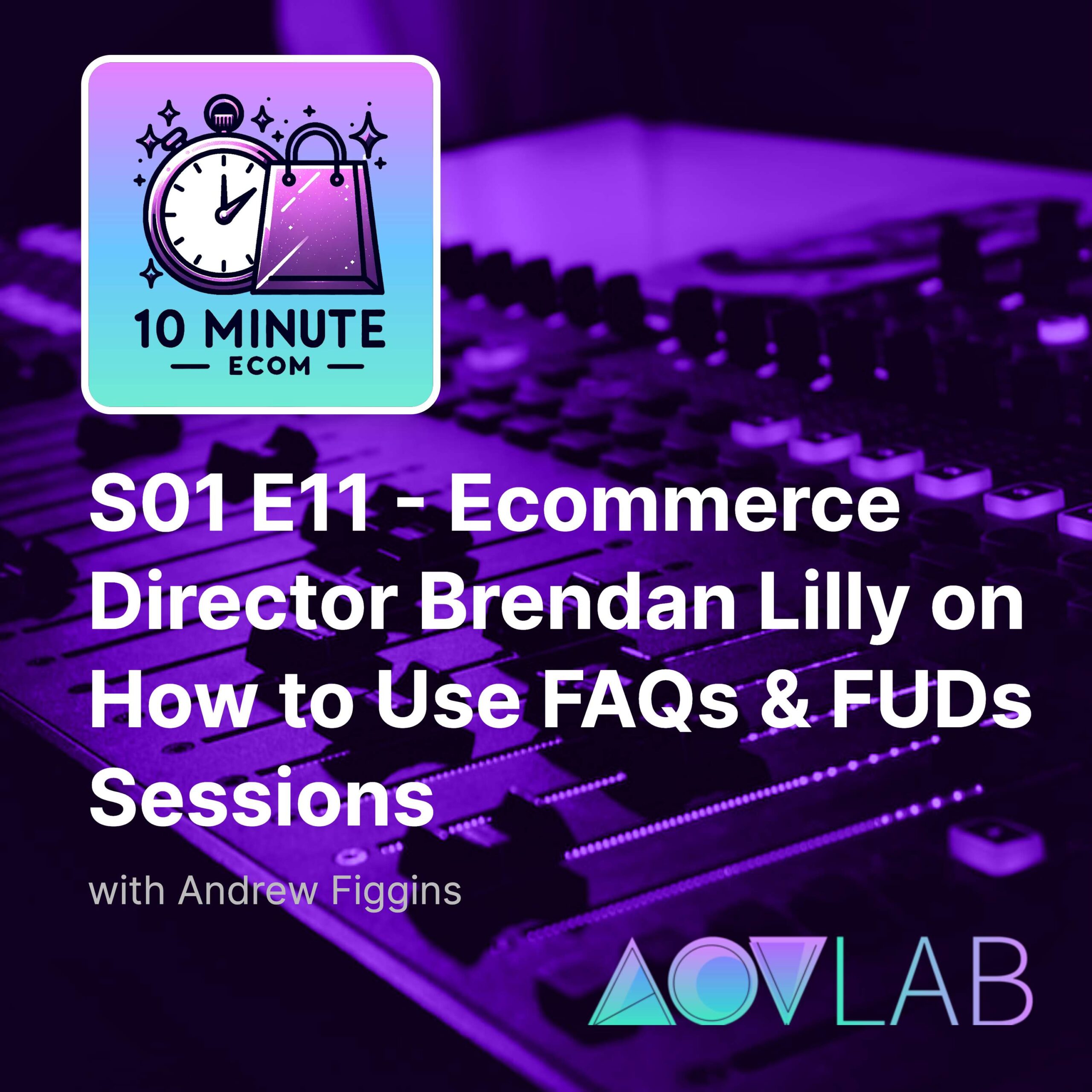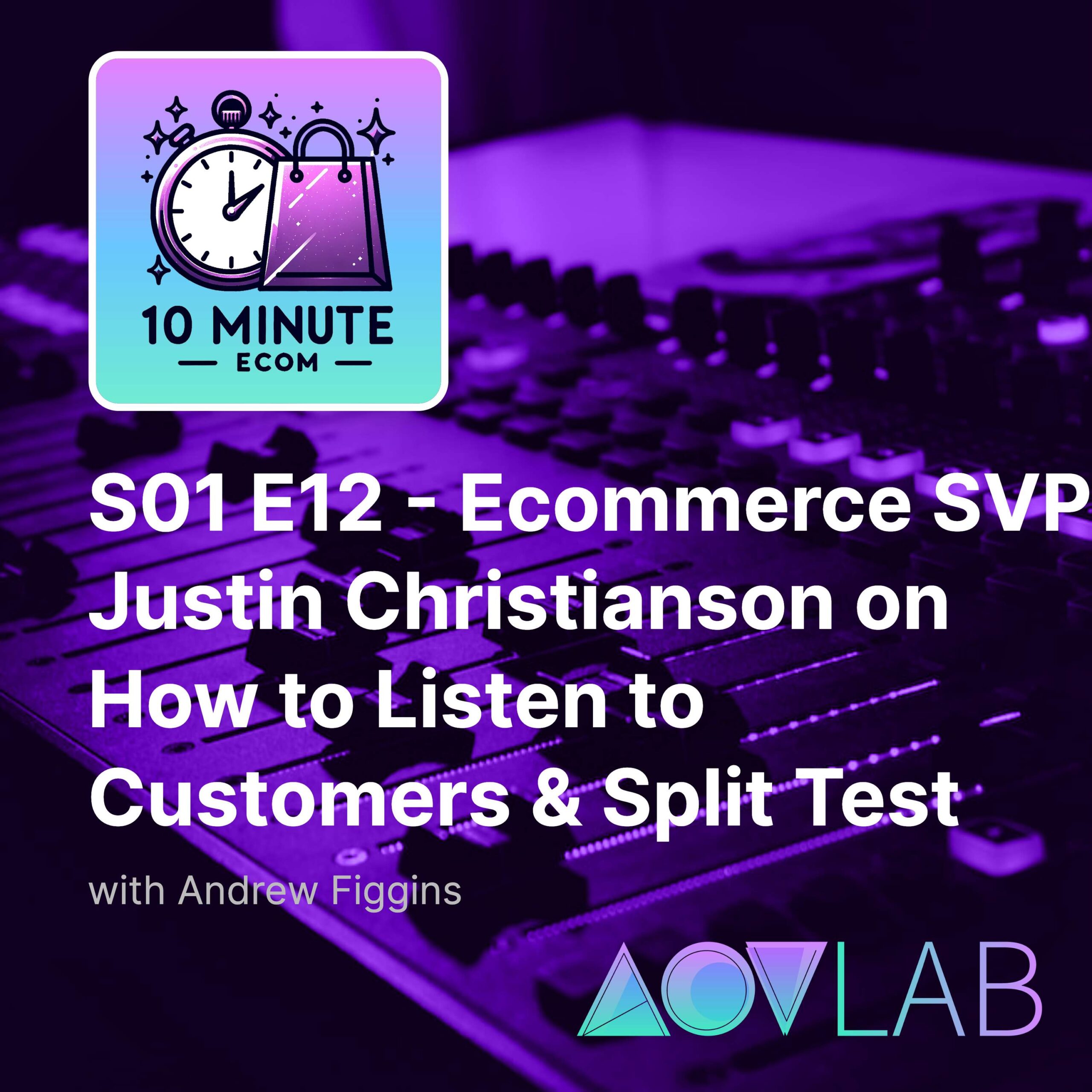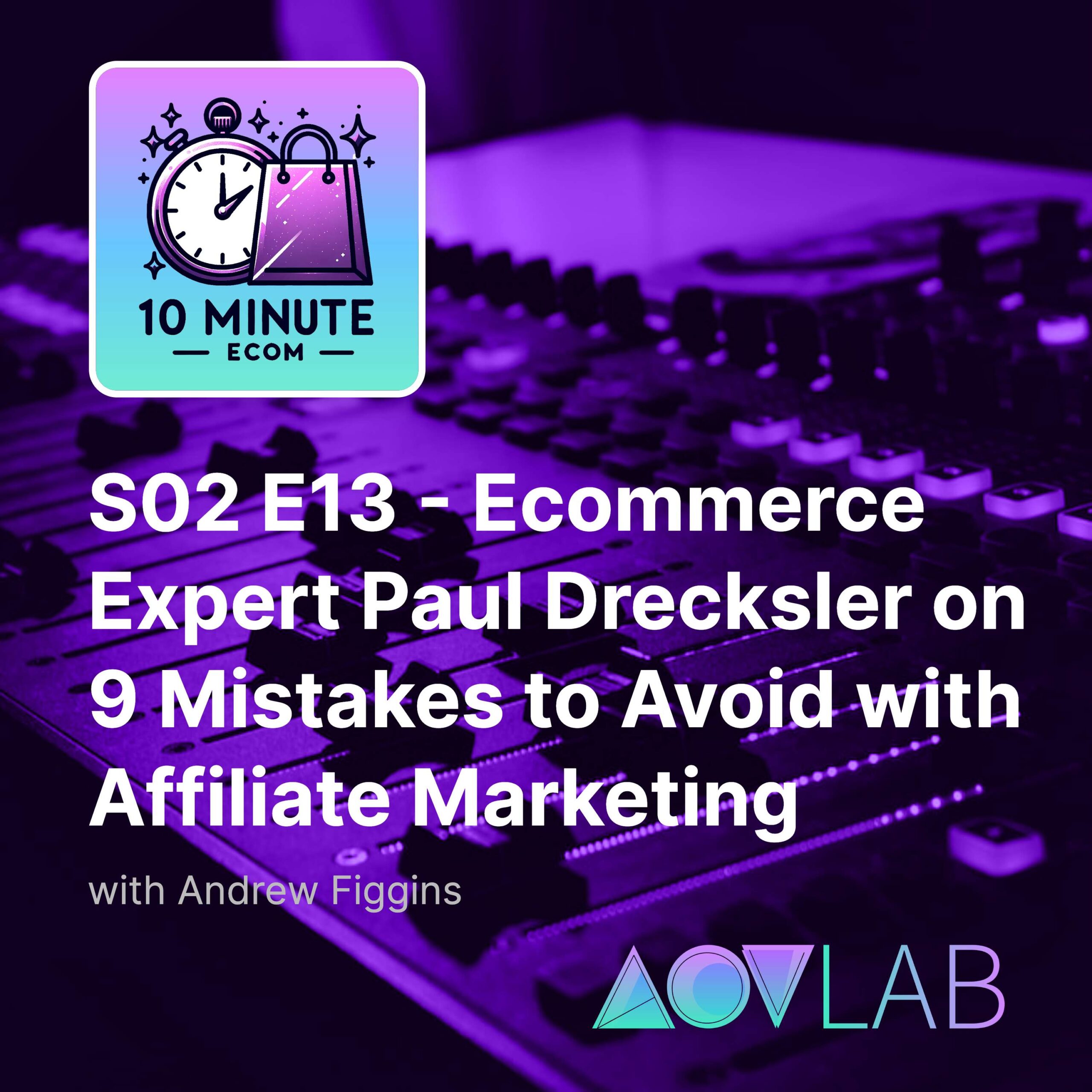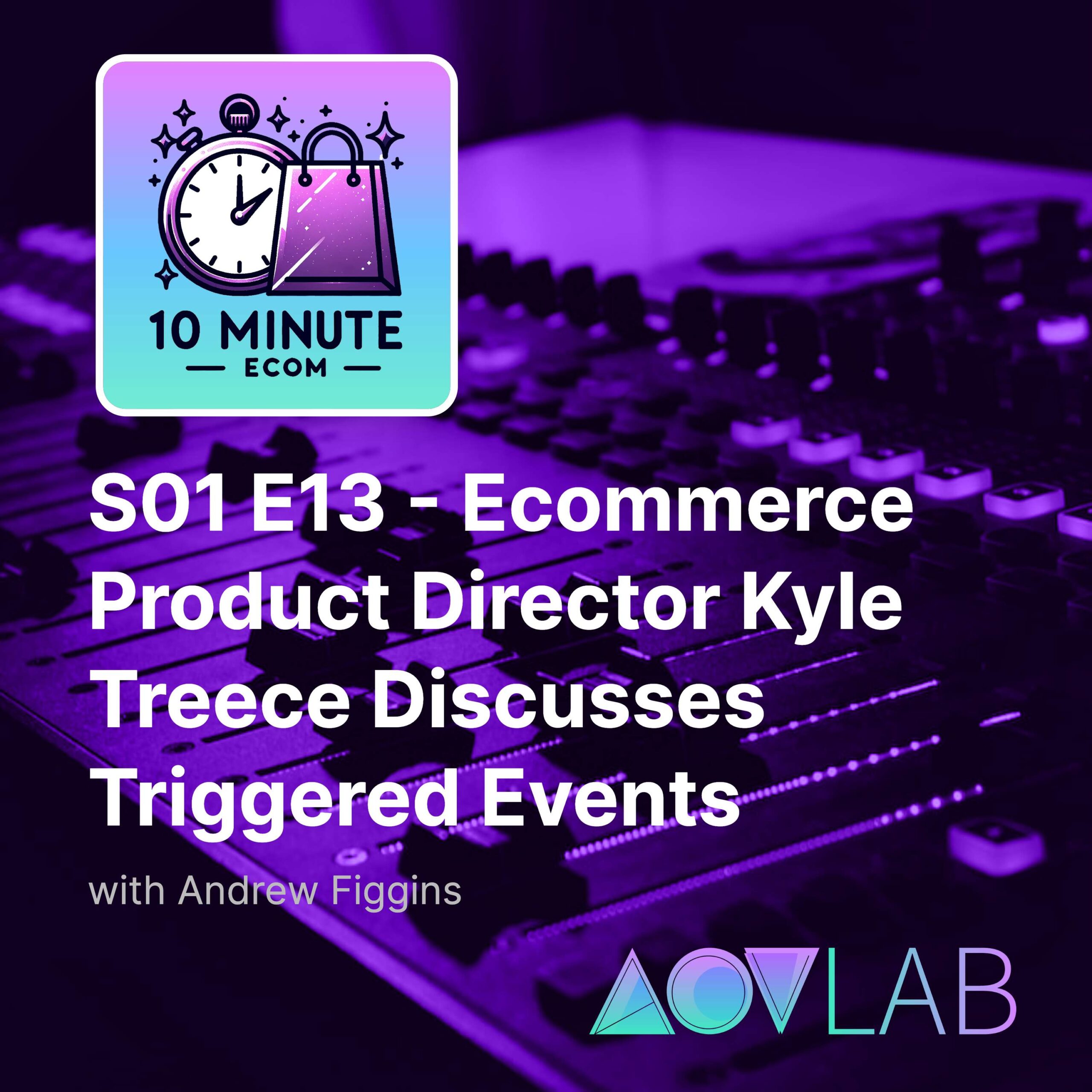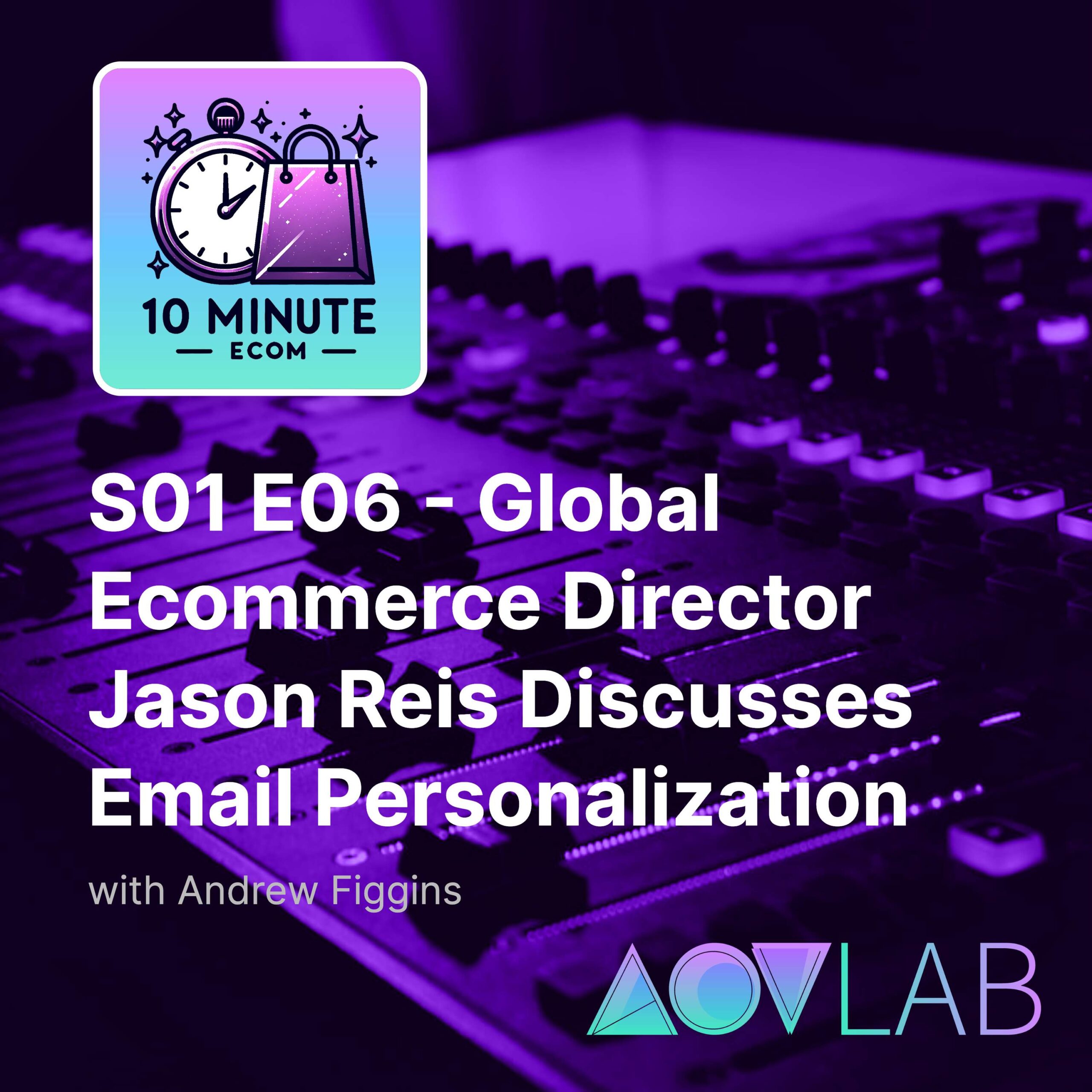Guest: Brendan Lilly, Director Ecommerce, F.W. Webb CompanyHost: Andrew Figgins, Founder, AOV Lab Episode Synopsis:Brendan shares his experience operating team “FAQs and FUDs” team sessions, as a way to engage his Ecommerce team in improving the customer experience. Transcript: [00:00:15] Andrew: Hello Ecommerce fans, and welcome to 10-Minute Ecom, an AOV Lab podcast. Every episode, we break down a new and different tactic that can help you improve your ecommerce KPIs (key performance indicators). I’m your host, Andrew Figgins, and like most of you, I am an e commerce professional. You may know me as the founder of AOV Lab, the […]
View Full Transcript
Episode Transcript
[00:00:13] Speaker A: Ecommerce fans, and welcome to ten minute ECom, an AOV Lab podcast. Every episode we break down a new and different tactic that can help you improve your ecommerce KPIs key performance, its indicators. I'm your host, Andrew Figgins, and like most of you, I am an ecommerce professional. You may know me as the founder of AOV Lab, the former vp of digital product innovation at Scrubs and beyond, the former director of e commerce technology at Rural King, or just from LinkedIn.
Today I'm excited to be talking to Brendan Lilly, an e commerce colleague that has held a variety of interesting roles in ecommerce, including at FW web company.
Anyway, Brendan, what did you come on the show today to share with your ecommerce colleagues?
[00:00:59] Speaker B: Hi, I'm Brendan Lilly with the FW web company out of the northeast United States. One thing that I've seen that works in e commerce is the facts and fuds exercise as a team building and customer experience development.
[00:01:13] Speaker A: Thank you, Brendan. And in case you didn't catch his last word there, his audio cut out.
[00:01:17] Speaker C: Just a little bit.
[00:01:19] Speaker A: The fax and fuds exercise as a team building and customer experience development tool. This is a great topic and something that was very unexpected to come up as a tactic on ten minute Ecom, but hope you enjoy it after the ad.
[00:01:35] Speaker C: We'll get right into the chat.
[00:01:37] Speaker A: Today's episode of ten minute Ecom is brought to you by Thrive commerce. If you are struggling to get your onsite promotions seen and engaged with, thrive ecommerce is a Goto tool that can help. I am actually a repeat customer of Thrive, most recently with Chefware.com, and I can't say enough about how impactful their tools are at driving increased conversion and revenue. If you'd like to set up a discovery call with Rive, head over to AOV lablab.com and tap on vendor network to set up your 30 minutes discovery call and to see what all the fuss is about.
And now back to the show.
[00:02:14] Speaker C: Awesome, Brendan, I'm happy to be talking to you today here on ten a minute, Ecom. Tell me a little bit about facts and fuds, because this was a new concept to me. I knew the acronyms, faqs and fuds. But tell me a little bit about this and how you're using it for team building.
[00:02:33] Speaker B: So one thing, looking at our analytics, especially on b to C sites, more and more customers are landing on pages other than home page, right? They're product driven searches and new customer acquisition often lands on various pdps or clps, you're targeting those. And long story short, for some of the lesser known brands, you have to find a way to communicate all the facts and fuds to those customers within a PDP. It's not just about the product image and the price. It goes beyond that into trust in completing a transaction with you and who your company is. And are you an authorized reseller? Right.
[00:03:13] Speaker C: That makes sense to me, yeah, absolutely. And I think you mentioned, we were chatting about this tactic a little bit before the recording today, and you mentioned that it's not just for ecommerce professional, but you actually get a broader team involved.
[00:03:28] Speaker B: And that's the fun part of this. It's a brainstorming group activity where you build buy into the overall customer experience, and there's a lot of contributions that different roles can have. To this. We would not only have our SEO guy or our marketing person, or the data governance person, but also sales team, IT team, everyone involved in really having a group discussion about what customers see when they come to the page. And does it cover all of their questions and all of their doubts and uncertainties in completing a transaction with us? And so we put up using either a whiteboard or whatever medium you want, brainstorm and put together the list, and then from there you work on how do you integrate it and implement those ideas into the site.
[00:04:13] Speaker C: I wanted to ask you a little bit about some specific ones that you've experienced in the past where you've had the meeting, you've got your brainstorming session, you've got your whiteboard. Have there been a couple of things, like insights from the team, or maybe even an unexpected person? Like you said, when you've got that cross functional team, sometimes you've got people who have been in the business for 510, 1520 years, but they're not technical people. That means nothing because they can be product experts. They can bring so much just interesting background. What's been something that maybe someone's brought up in one of the facts and fuds sessions that surprise you?
[00:04:54] Speaker B: One of the more interesting components. And this goes into the overall catalog structure and data structure. We're moving into current companies, moving into a new PIM system here in the next week. And in terms of organizing related products in the different types of cross references, whether it's a universal replacement, whether it's a direct replacement, whether it's just a variant of the product. Right. And understanding how different customers view those and how to display that in a relevant manner is one of the things that is always fascinating to me in various companies and working with the sales team, particularly, sometimes I think color might be the most relevant switch. Right. And that's just from the retail perspective, whereas in b two b, they're looking at a specific technical component. Right. And working with the teams to understand how those different references and different related products come in is always one of the more interesting components alongside all the basic stuff of cross cells and that kind of thing that you can drive from data.
[00:06:03] Speaker C: I did have a question. Something came to mind when you were mentioning, I think, the facts and FUd session that I wanted to ask you about, which is with a b testing sometimes in the past, I found it's either taking an element away or it's adding something new. In my experience, a lot of it's been taking things away from the page. Has that been anything that you all have found as you've gone through some of those sessions is maybe some elements that didn't really need to be there? Or are you saying in many cases that it's like it's the addition of something? Like you mentioned, it's a badge, it's some more text.
[00:06:40] Speaker B: There's tons of places to bury information on a PDP or anywhere on the site. And one of the things I've moved away from is really the kind of fluffy SEO copy that was all the rage for years. And that really is more of a distraction. One, people just don't read paragraphs anymore, and if you do need to have that for SEO purposes, maybe you. I guess the key to a PDP is organization, right? Not only having all the components, but making sure that you have it organized in a way that is relevant to the user. Again, most of them are not reading these long multi paragraph descriptions that you buried a bunch of keywords or topics in. Right. So that's the one thing I've moved away from, and we've stopped investing in that largely. And again, the organization is just putting people in understanding what are the priorities and what do they need to see above the fold and how do they digest and proceed with consideration of purchasing.
[00:07:35] Speaker C: Excellent. You mentioned this tactic is a good team building tool.
Tell me a little bit about that aspect of it. And is there a particular type of team member that lends themselves well to this type of thing?
[00:07:50] Speaker B: Yeah, this is where the really interesting component has been for me. It's sometimes the people that are furthest from the customer that really get engaged in this. Obviously, the salespeople are happy to share anything and everything about their experience. Right. But honestly, I've had some people that have been working in data Gov for 20 plus years, all of a sudden really start to engage in how their work is being interpreted and viewed and considered by the customer. And that was always a really fun part of that experience.
[00:08:21] Speaker C: Yeah, it's hard to imagine like data governance people being in that mode, but that's pretty impressive that you're able to work it in a way that you can draw out that experience.
[00:08:32] Speaker B: Yeah, exactly. And it goes back to it helps them value their role within the company and their role within the customer experience and driving revenue.
[00:08:42] Speaker C: Absolutely.
So, Brendan, I wanted to ask you about this, just in terms of its effectiveness. I think this sounds like it's something that maybe could even have a larger impact if done right. Talk a little bit about how to do this right and what the impact can be.
[00:08:56] Speaker B: Absolutely. After the brainstorming, then you actually have to get the work done right in the implementation phase and it is helpful. And I find more cross functional teamwork in implementing these changes. After doing this brainstorm together, it's not just a handed down idea from a product manager somewhere. Right. So that part is definitely a benefit during the implementation phase. But beyond that, I found this is one of the most effective revenue drivers in ecommerce. It's really solidifying. And building out those pdps as revenue.
[00:09:28] Speaker C: Drivers themselves, that's pretty neat. It sounds like you've got a way that you can basically get not only one voice to the customer, but you're getting a combined lots of eyes and lots of voices and lots of perspectives that you've been able to draw in from your team, which is great. Wanted to ask you just one last question. This is ten minute ECOM, and so.
[00:09:49] Speaker A: We don't have a whole lot of.
[00:09:50] Speaker C: Time today, but is there anything else that you'd like to just share or say to your colleagues in ECOM that might be listening today?
[00:09:58] Speaker B: Yeah. So one of the things that I really love is seeing this community evolve and seeing that we spoke about this, that for several years there was just simply not enough fresh content. There was a couple of podcasts starting and stopping around this stuff. There wasn't much information out there. Now there's more content coming out and the community is really starting to build. And that's exciting.
[00:10:18] Speaker C: And it's a great place, I think, for us to end up today, because really that is the goal of AOV lab. And this podcast is meant to be a resource for folks like us, folks in the ECOM that have been in for a while. Whether you've been in ecommerce for a while or you're just getting started. I think it's great to hear a tattoo like this, Brennan, that you brought on the show today because it can apply to so many teams that are out there. So thanks again. It's been a pleasure.
[00:10:45] Speaker B: Thank you. Appreciate it.
[00:10:47] Speaker A: Well, we've hit that ten minute mark, so that's a wrap for today's episode. I want to again thank our guest Brendan Lilly. If you have a moment, be sure to subscribe like, or follow the show on Apple Podcasts, Spotify, Amazon Music, Google Podcasts, or wherever it is that you listen. There is yet another way to support the show, and that's by being a guest on the show. If you work in Ecom and you're listening and you're thinking, I could do that, I've got a tactic to share. Well, first, I'd like some credit for being a mind reader. Others within my solar system, including some orbiting nearby, do not think I'm a mind reader, and you are evidence to the contrary. And I think that's real special. But if you thought that, and you do have a tactic that you'd like to share with your colleagues in ecommerce, reach on out to humans at AOV Lablab Ecom and tell them that Andrew sent you. I hope you enjoy this episode of the show. Until next time, this is Andrew Figgins signing off and saying, have a good one.
